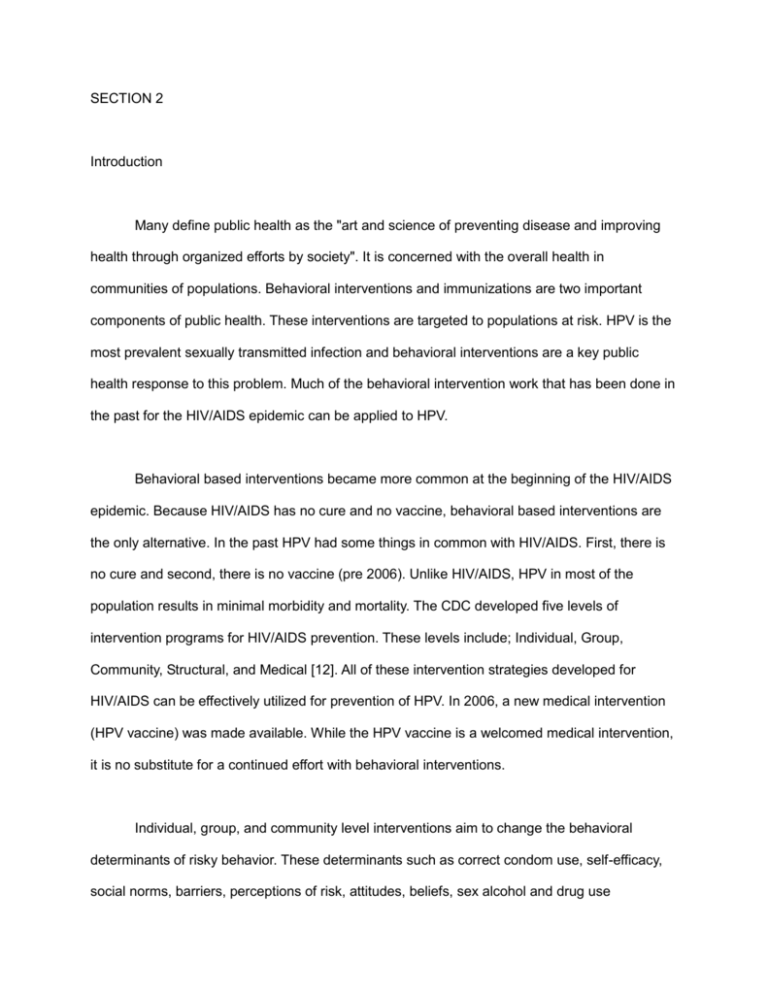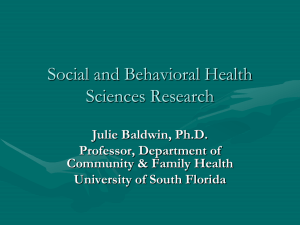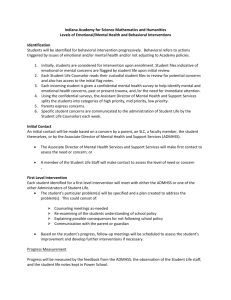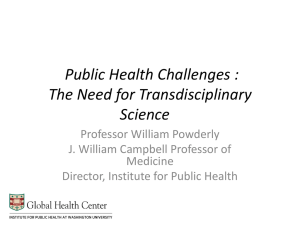
SECTION 2
Introduction
Many define public health as the "art and science of preventing disease and improving
health through organized efforts by society". It is concerned with the overall health in
communities of populations. Behavioral interventions and immunizations are two important
components of public health. These interventions are targeted to populations at risk. HPV is the
most prevalent sexually transmitted infection and behavioral interventions are a key public
health response to this problem. Much of the behavioral intervention work that has been done in
the past for the HIV/AIDS epidemic can be applied to HPV.
Behavioral based interventions became more common at the beginning of the HIV/AIDS
epidemic. Because HIV/AIDS has no cure and no vaccine, behavioral based interventions are
the only alternative. In the past HPV had some things in common with HIV/AIDS. First, there is
no cure and second, there is no vaccine (pre 2006). Unlike HIV/AIDS, HPV in most of the
population results in minimal morbidity and mortality. The CDC developed five levels of
intervention programs for HIV/AIDS prevention. These levels include; Individual, Group,
Community, Structural, and Medical [12]. All of these intervention strategies developed for
HIV/AIDS can be effectively utilized for prevention of HPV. In 2006, a new medical intervention
(HPV vaccine) was made available. While the HPV vaccine is a welcomed medical intervention,
it is no substitute for a continued effort with behavioral interventions.
Individual, group, and community level interventions aim to change the behavioral
determinants of risky behavior. These determinants such as correct condom use, self-efficacy,
social norms, barriers, perceptions of risk, attitudes, beliefs, sex alcohol and drug use
knowledge, and behavioral intentions can all be used as a route to behavior change. Structural
interventions are focused more on practiced based policies (law and public policy) such as
testing, prophylaxis, medications, and other services that indirectly affect risk behaviors. Medical
interventions are not generally considered behavioral interventions but they often require the
use of behavioral interventions to promote their adoption and use. The HPV vaccine is a great
example of a medical intervention that requires behavioral based interventions to promote it's
adoption and use.
CDC - REP+ Behavioral Interventions
The CDC has an ongoing effort to compile and assemble examples of effective HIV
interventions [13]. These throughly researched HIV interventions can be utilized for HPV. The
first CDC list identified 24 effective interventions out of 223 relevant studies that include four risk
groups. These groups include drug users, heterosexual adults, male homosexuals, and youth.
The second list identified 18 additional effective interventions out of 100 relevant studies across
the same risk groups. Based on these successful interventions, the CDC has developed the
"Replicating Effective Programs Plus (REP+)" HIV program [14]. These behavioral based
interventions can be utilized for HPV awareness and preventative health.
The REP+ program includes ten different behavioral based interventions:
1. Video Opportunities for Innovative Condom Education and Safer Sex (VOICES)
2. Popular Opinion Leader (POL)
3. Real AIDS Prevention Project (RAPP)
4. The Mpowerment Project
5. Street Smart
6. Community Peers Reaching Out and Modeling Intervention Strategies (PROMISE)
7. Living In Good Health Together (light)
8. RESPECT
9. Partnership for Health
10. Healthy Relationships
The CDC's ten behavioral based interventions makeup the REP+ program. Each of the
ten component of the package have targeted populations and well documented outcomes. Each
component was developed based on scientific based behavioral theory. Details of each
research design are available in peer reviewed journals [15-24]. Technical assistance and
training are available through CDC affiliated organizations. All ten components of the REP+
program are great examples of what's been done and where these interventions have been
successful. Interventionists can use any one or more of the components in their unique
interventions.
The first REP+ program is titled "Voices: Video Opportunities for Innovative Condom
Education and Safer Sex". The Voices intervention is a single session video on HIV/STD
prevention through condom use and condom negotiation skills. The program is based on the
theory of reasoned action. This theory is grounded on the principles that behaviors are guided
by attitudes, beliefs, experiences, and the expectations of others. The theory accommodates
culture and gender based differences. The "Voices" intervention is most effective when it is
delivered at a teachable moment, as when someone visits a health clinic. The target population
of "Voices" is African-American and Latino adult men and women. Health educators assemble
groups of 4-8 persons to watch a video, review printed and poster material, and discuss the
information. Health educators answer questions and guide the participants through the
information. At the end of the 45 minute session, participants are provided condoms that best
meet their needs.
The second REP+ program is titled "Popular Opinion Leader (POL): A Community
AIDS/HIV Risk Reduction Program for Gay Men". The POL intervention recruits a cadre of
trusted men who frequent gay bars and trains them to promote safer sexual behaviors in casual,
one-on-one conversations with peers at bars and other settings. The program is based on
diffusion of innovation and social influence principles. The target population of "POL" is men
who frequent gay bars. Health educators invite the gay men to attend a 2-day training session
where they learn how to conduct the intervention, and practice delivery and implementation
skills. The program includes a manual, video of POL techniques, logo buttons, and posters.
The third REP+ program is titled "Real AIDS Prevention Project (RAPP): A CommunityLevel HIV Prevention Intervention for Inner-City Women. The RAPP intervention recruits a cadre
of peer network leaders that includes sexually active women and their male partners. The
program is based on social learning and diffusion of innovation principles. The program includes
outreach, small group workshops, and community mobilization. Peer net-workers attend a 2-day
training session that role plays stage-based encounters and a 1-day training session on
developing community role model stories.
The fourth REP+ program is titled "The Mpowerment Project: A Community-Level HIV
Prevention Intervention for Young Gay Men". The Mpowerment intervention is run by a core
group of 10-15 young gay men from the community. The program is based on diffusion of
innovation theory. The program targets young gay and bi-sexual men ages 18-29. The program
includes videos, materials, and information on conducting the intervention.
The fifth REP+ program is titled "Street Smart: Reducing HIV Risk Among Runaway and
Homeless Youths". The target population is runaway youths ages 11 to 18. The program is
based on the social learning theory. The intervention consist of 8 1.5-2.0 hour drop-in sessions
delivered over a 2 to 6 week period. Video, handouts, and training materials serve to instruct the
runaway youths on substance abuse and unsafe sex practices.
The sixth REP+ program is titled "Community PROMISE: Peers Reaching Out and
Modeling Intervention Strategies for HIV/AIDS Risk Reduction in their Community. The
PROMISE intervention targets injection drug users, female sex partners, sex workers,
homosexuals, and high risk youth. The intervention is based on the reasoned action and social
cognitive theories. Videos, handouts, intervention manuals, condoms, and bleach kits are
provided.
The seventh REP+ program is titled "light: Living In Good Health Together, the NIMH
Multisite HIV Prevention Trial". The light intervention targets men and women aged 18 and older
who visit STD clinics. The intervention is based on the behavioral theory. Four videos,
anatomical models, sample materials, handout, and manuals are provided.
The eighth REP+ program is titled "RESPECT: Two Models of Effective Individual, Clientfocused HIV Prevention Counseling Interventions". The RESPECT intervention targets
heterosexual persons (14 and older) attending STD clinics. The intervention is based on the
reasoned action and social cognitive theories. Manuals, videos, and other materials are
provided. The target audience attends either a brief counseling session or a enhanced
counseling session. The brief session include two 20 minute one-to-one interactive counseling
sessions. The enhanced session includes one 20 minute and three 60 minute one-to-one
interactive counseling sessions.
The ninth REP+ program is titled "Partnerships for Health: A Brief Safer-Sex Intervention
in HIV Clinics". The partnership for health intervention targets HIV positive men and women.
The intervention is based on the social cognitive theory. Manuals, brochures, stickers, posters,
flyer's, and videos are provided. The program includes a medical exam and counseling session
designed to provide patient referrals to services needed and reinforce safe sex behavior.
The tenth REP+ program is titled "Health Relationships: Prevention for Positives". The
healthy relationships intervention is targeted at HIV positive men and women. The program
includes manuals, videos, risk banners and cards, and education on safe sex behavior. The
program assembles groups of 5 to 12 HIV positive participants of the same sex and sexual
orientation for a 2 hour session designed to educate and encourage self-efficacy and selfevaluation in order to promote positive behavioral change.
All of the CDC REP+ programs are proven behavioral interventions based on health
behavior theories. Each one has a record of positive outcomes that have provided a significant
public health benefit in reducing the incidence of HIV/AIDS, and other STI's. The CDC REP+
program was launched in 1999 and is a model program for the reduction of HIV/AIDS but can
be used with some modifications for any STI behavioral intervention including HPV.
HPV and Other Behavioral STD Interventions
The literature contains a small number of journal articles on the subject of HPV
behavioral interventions. Much of the literature on HPV covers medical interventions (HPV
vaccine). The vaccine has been available globally for two years. Since much of the prior
behavioral focus was on HIV/AIDS and unwanted pregnancies, very few studies on HPV exist.
One interesting study published by the journal Pediatrics focused on whether simply
providing information on HPV and the available vaccine was enough to influence parents’
intention to vaccinate their adolescent children. The study had a control and experimental
group. Each group received a three sentence paragraph explaining what HPV was and the
availability of the vaccine. The experimental group received an additional one page “fact sheet”
discussing HPV in a more comprehensive fashion. The study concluded that while the group of
parents who received the fact sheet had an increased knowledge of HPV, it had little effect on
their intention to warrant or not warrant their child receiving the vaccination. [25] (Dempsey et al.
2008). The study failed to change behavior using information as a primary construct in an
intervention. The design could have been improved if it had expanded the use of behavioral
constructs. As the author discerned, attitude was shown to be one of the strongest predictors to
parents’ intentions. This would most likely be an excellent starting point if one were to modify the
experiment. According to the theory of planned behavior, attitude is a direct predictor of
intention, but attitude is influenced by two entities; behavioral beliefs and the evaluation of
behavioral outcomes. These are the two elements that must be explored when developing a
behavior based intervention aimed at parents. An excellent way of gauging attitude is initial
interviews, or pre-survey probing parents on concerns they have related to HPV and
vaccinations. Once the specialist performing the intervention has an understanding of these
concerns, they can be successfully integrated into the information sheet or other medium of
information delivered to the parents.
The use of “information only” interventions has been tested in other studies. It has been
shown that simply providing information, is assuming people will act “rational” and that
knowledge is the single determinant [26] (Cathran et al. 2002). Through the lens of many
different theories we can see that there are numerous factors influencing health behaviors. For
example, in the integrated behavior model, information or “knowledge” is a predictor of behavior
change, however there are several others. Intention is the largest predictor of behavior, and
knowledge does not increase intention as much as self-efficacy, normative beliefs and attitude.
[27] (Glanz 2008).
In another study, the second construct concerning attitude; evaluation of behavioral
outcomes was not adequately addressed. More emphasis needed to be placed on both benefits
of administering the vaccination and combating fears of negative effects associated with the
vaccination [28] (Dempsey et al. 2008). The authors of this study lacked a theoretical approach
and use of constucts in designing the intervention. The use of information and education only
limited the effectiveness of the intervention.
An example of a more theoretically based intervention is Effects of a Brief, Theory-Based
STD-Prevention Program for Female College Students [29]. The study tested two health
behavior theories, and tested relevance of individual theory constructs. Three groups of college
females reported inconsistent condom use with multiple partners. The first group participated in
a 150 minute informational session. The second group participated in a 150 minute session that
included information and motivational techniques. The control group was placed on a wait-list
with no session immediately provided. The informational session was very straight-forward. The
participants were informed that this was an “opportunity for the participants to learn about STD
transmission, consequences, prevention, and treatment.” [29] (Jaworski et al. 2008). Special
effort on the part of the facilitator was made not humanize the threat of STD’s. The second
group session was guided heavily by Fisher using Fisher’s Information-motivation-behavior
skills model (IMB) [29] (Jaworski et al. 2008). According to the authors, the third session
“implemented the five therapeutic principles of the motivational-enhancement approach" in that
they: (1) expressed empathy; (2) increased awareness of the discrepancy between stated safety
goals and actual risk behavior; (3) avoided argumentation; (4) “rolled” with resistance; and (5)
supported self-efficacy. The group format was used to create a social context in which riskreduction was normative and supported [29] (Jaworski et al. 2008).
The conditions of the three groups in the experiment were evaluated and an immediate
and two-month follow up survey was completed by the participants. Both the informational and
IMB sessions had increased knowledge pertaining to STD’s. It was concluded that the
participants subjected to the IMB theory guided session reported reduced number of sexual
partners compared to the control and informational groups. Unfortunately, it did not affect their
intentions, attitudes on unprotected sex, or condom use behaviors. The study provides insight
on how one might design a more effective curriculum for educational sessions.
Although the methods of the study showed increased STD knowledge in both
experimental groups, the lack of behavior changes suggests a fundamental flaw. The
intervention did an ineffective job of influencing perceived threat. By providing an overtly
empathetic setting and an environment that “rolls with resistance”, facilitators may have
inherently excluded the seriousness of risk. This is an excellent example of where fear
messages could be integrated successfully into the curriculum. The curriculum already provides
tools and resources for alternative behavior and a strong component addressing self-efficacy,
however, it is missing fear messages that can elicit perceived risk.
A third and very common source of HPV prevention and intervention is an individual’s
primary care clinician or pediatrician. However, clinicians have expressed concerns about how
and when to provide counseling concerning HPV among adolescents and teenagers [30]
(Sussman et al. 2007). Some of these concerns were, rapport with patient was necessary but
difficult to build especially when many patients of the target age group (10-13 yrs.) are
accompanied by parents. In order to discuss topics of sexual health and disease transmission,
clinicians felt a presumption of sexual activity had to occur, and gauging readiness of the patient
to discuss topics was situational and methods varied from causal to very direct [30] (Sussman et
al. 2007). This study aimed at understanding the use of primary care visits as a tool to
administer HPV prevention, found several themes that suggest that using primary care visits as
a method of education has systemic flaws [30] (Sussman et al 2007). In analyzing primary care
through health behavior models, we can see that while clinicians can provide knowledge and an
alternative (offering vaccination), they most likely can do little in terms of influencing attitude,
normative beliefs and self-efficacy in a short appointment.
Because the optimal age for the administration of the HPV vaccine is before any sexual
activity has occurred, decision is heavily influenced if not decided by parents. This implies
intervention efforts should be focused on harboring acceptance among parents of adolescent
girls [31] (Gonik 2006). Overall there is good intention on the part of the parent to have
daughters vaccinated. In one study attempting to analyze predictors and statistics of parental
improvement, researchers found that over 70% of parents intended to vaccinate their daughters
[32] (Ogilvie et al. 2007). The survey also found that the largest concern of parents was that
vaccination would affect the sexual behavior of their daughters. Namely, if the daughters felt
protected from HPV they might engage in more un-safe sex. The survey reveals valuable
information and challenges as well. We can classify and address these concerns and
challenges using attitude of behavior and intrapersonal models. Unfortunately, these deep
rooted attitudes are difficult to address with traditional behavioral interventions.
Conclusion
The CDC's REP+ program of HIV/AIDS behavioral interventions are a valuable starting
point in the design of HPV behavioral interventions. Using this information and other STI and
HPV intervention successes, researchers can design and implement HPV behavioral
interventions that have a good chance of success. For this to happen, interventions and
awareness programs must address most if not all elements that affect intention to perform
behavior. Simply providing information will not be sufficient to have the needed changes on
behavior. Understanding how behaviors are guided by constructs are the keys to success in
health education, health promotion, and health behaviors.
REFERENCES
[12] Noar, Seth. (2007). Fact Sheet: Behavioral Interventions for Reducing Sexual Risk
Behavior. Rural Center for AIDS/STD Prevention. Indiana University Press. 21, 1-4.
[13] Centers for Disease Control and Prevention. (2001). Compendium of HIV prevention
interventions with evidence of effectiveness. Department of Health and Human Services.
Division of HIV/AIDS Prevention. Atlanta, GA.
[14] Centers for Disease Control and Prevention. (2007b). Replicating Effective Programs Plus.
Department of Health and Human Services. Division of HIV/AIDS Prevention. Atlanta, GA.
[15] O’Donnell, L.N., San Doval, A., Duran, R., and O’Donnell, C. (1995). Video-based sexually
transmitted disease patient education: Its impact on condom acquisition. American Journal of
Public Health, 85(6), 817-822.
[16] Kelly, J. A., Murphy, D. A., Sikkema, K. J., McAuliffe, R. L., Roffman, R. A., Solomon, L. J.,
Winett, R. A., Kalichman, S. C. (1997). Randomised, controlled, community-level HIV-prevention
intervention for sexual-risk behaviour among homosexual men in US cities. Community HIV
Prevention Research Collaborative. Lancet, 350(9090), 1500-1505.
[17] Lauby, J. L., Smith, P. J., Stark, M., Person, B., and Adams, J. (2000). A community-level
prevention intervention for inner city women: Results of the Women and Infants Demonstration
Projects. American Journal of Public Health 90(2), 216-222.
[18] Kegeles, S.M., Hays, R.B., Coates, T.J. (1996). The Mpowerment Project: A communitylevel HIV prevention intervention for young gay men. American Journal of Public Health, 86(8),
1129-1136.
[19] Rotheram-Borus, M. J., Koopman, C., Haignere, C., & Davies, M. (1991). Reducing HIV
sexual risk behaviors among runaway adolescents. Journal of the American Medical
Association, 266(9), 1237-1241.
[20] The CDC AIDS Community Demonstration Projects Research Group. (1999). Communitylevel HIV intervention in 5 cities: Final outcome data from the CDC AIDS Community
Demonstration Projects. American Journal of Public Health 89, 336-345.
[21] The National Institute of Mental Health (NIMH) Multisite HIV Prevention Trial Group (1998).
The NIMH Multisite HIV Prevention Trial: Reducing HIV Sexual Risk Behavior. Science, 280,
1889-1894.
[22] Kamb, M.L., Fishbein, M., Douglas, J.M., Rhodes, F., Rogers, J., Bolan, G., Zenilman, J.,
Hoxworth, T., Malotte, K., Iatesta, M., Kent, C., Lentz, A., Graziano, S., Beyers, R.H., Peterman,
T.A., for the Project RESPECT Study Group. (1998). Efficacy of Risk-Reduction Counseling to
Prevent Human Immunodeficiency Virus and Sexually Transmitted Diseases: A Randomized
Controlled Trial. Journal of the American Medical Association, 280:1161-67.
[23] Richardson J.L., Milam J., McCutchan A., Stoyanoff S., Bolan R., Weiss J., Kemper C.,
Larsen R.A., Hollander H., Weismuller P., Chou C.P., and Marks G. Effect of brief safer-sex
counseling by medical providers to HIV-1 seropositive patients: A multi-clinic assessment. AIDS
2004;18:1179-1186.
[24] Kalichman, S.C., Rompa, D., Cage, M., DiFonzo, K., Simpson, D., Austin, J., Luke, W.,
Buckles, J., Kyomugisha, F., Benotsch, E., Pinkerton, S., and Graham, J. (2001). Effectiveness
of an intervention to reduce HIV transmission risks in HIV-positive people. American Journal of
Preventive Medicine 21(2), 84-92.
[25]
[26]
[27]
[28]
[29]
[30]
[31]
[32]








